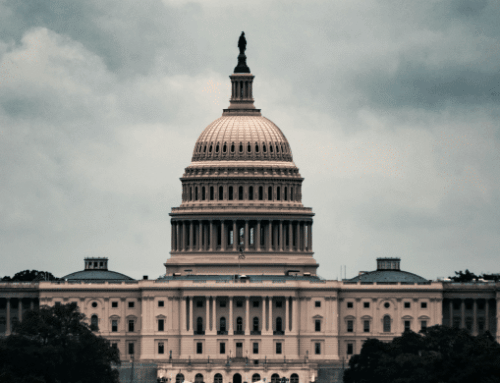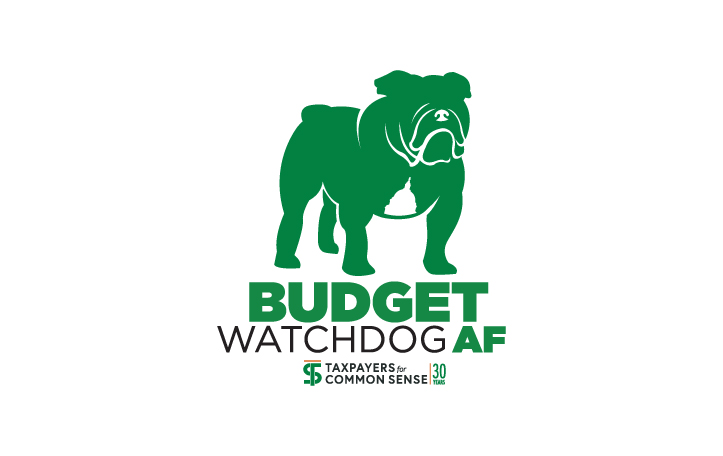In this episode of Budget Watchdog All Federal, Steve Ellis and Josh Sewell analyze President Trump’s newly released “skinny budget” for fiscal year 2026, which proposes $163 billion in cuts primarily to domestic programs while increasing funding for defense, homeland security, and border security. Get the TCS take on how these dramatic spending shifts might impact vulnerable populations, and whether these changes would meaningfully address the nation’s growing debt.
Transcript
Announcer:
Welcome to Budget Watchdog All Federal, the podcast dedicated to making sense of the budget spending and tax issues facing the nation. Cut through the partisan rhetoric and talking points for the facts about what’s being talked about, bandied about and pushed to Washington, brought to you by taxpayers for common sense. And now the host of Budget Watchdog AF TCS President Steve Ellis.
Steve Ellis:
Welcome to All American Taxpayers Seeking Common Sense. You’ve made it to the right place for 30 years. TCS, that’s taxpayers for common sense, has served as an independent nonpartisan budget watchdog group based in Washington dc. We believe in fiscal policy for America that is based on facts. We believe in transparency and accountability because no matter where you are on the political spectrum, no one wants to see their tax dollars wasted. It’s May, 2025 and President Trump has just released his first budget proposal since returning to office. It includes $163 billion in proposed cuts across government, but some spending increases as well. There’s a lot to unpack, including whether the cuts will stick and what they mean for fiscal policy. Joining me today to dive into details is our very own director of research and policy, Josh Sewell. Welcome back, Josh. Hey, it’s great to be here again, Steve. So Josh, let’s set the scene for everyone. The White House just released what’s being called a skinny budget for fiscal year 2026. What exactly is this document and what does it tell us?
Josh Sewell:
Well, Steve the Skinny budget is really the administration’s initial outline of its spending priorities. So it’s focusing primarily, at least this one on discretionary spending. That’s the roughly one quarter of federal spending that Congress appropriates each year as far as the total budget. And so this version for this president doesn’t include the full details on mandatory programs like Social Security, Medicare, farm Bill, Medicaid, and those things which actually make up the bulk of federal spending. Those details, they’re expected to come out later this month. And so instead, what this skinny budget does is it tells us the administration’s vision for dramatically reducing the size and scope of the federal government and what a vision
Steve Ellis:
It is in its 45 pages. The budget proposes that 163 billion in cuts I was mentioning, and it’s primarily to domestic programs. Can you walk us through some of the biggest proposed reductions or the most interesting?
Josh Sewell:
Yeah, sure. All president’s budgets have some interesting things in them, and oftentimes they have some things that you could call dramatic, but in this budget, the cuts are really striking both in the breadth of what they cover and the level of cuts that he is proposing. And so some of the deepest are to things that you might expect. They’ve been telegraphed already. So the State Department and international programs, it’s an 84% reduction. That’s nearly billion dollars. National Science Foundation, EPA, both above 50% cuts and housing and urban development see a 44% reduction. So that equates to about 33 and a half billion dollars. So really you throw in health and human services also, and that’s another 33 billion, a whole quarter of its budget. It’s a lot of money, but these are really just the highlights or I guess low lights depending on what you think of those agencies.
Steve Ellis:
Yeah, a lot of this seems like it’s been telegraphed by Doge that places that Doge was cutting right now in fiscal year 2025 or places that were going to get cut in fiscal year 2026. Right,
Josh Sewell:
Exactly. It’s not a huge surprise at some of this stuff, but this is a very significantly larger cut than any president. I’ve seen any of the president’s budgets in the past, including this president and his first administration.
Steve Ellis:
But it’s not all cuts, is it, Josh? I mean, there are some increases in a few departments, right?
Josh Sewell:
Yeah, doge notwithstanding, there are definitely some places the president is proposing significant increases, so Department of online Security, the one that deals with the border, for the most part, you’d see a massive 65% increase. That’s $42 billion. And that is again, really just about immigration enforcement and border wall issues in the Defense Department. Also, something that president’s a fan of would see a 13% boost. So structured in a slightly unusual way, we’ll say, because their counting reconciliation spending not just the regular budget process. And then also Veteran’s Affairs would get a modest 4% increase. And transportation, I guess it’s infrastructure week again, would get a 6% mo.
Steve Ellis:
Well, I would say considering reconciliation isn’t normally used for spending, though it’s trending that way. It’s a little more than slightly unusual approach. And so let’s talk about the defense spending. The administration is proposing to hold base defense spending flat, but then add 113 billion through reconciliation. Senator McConnell, defense Appropriations subcommittee chair called this an accounting gimmick. What’s your take?
Josh Sewell:
Well, yeah, I’d agree with Senator McConnell on this one. Of course, this is highly unusual. I mean, defense spending increases would every other year they come through the regular appropriations process, whether that’s, as you got folks listening might remember that the defense spending bill is one of the few bills that gets passed every single year. Very rarely. I think just last year was it the last time you had a full year continuing resolution. If there’s one thing they’re going to get done, it’s defense. And so by trying to push this increase through reconciliation and count it, the administration is essentially trying to count spending increase without actually doing it through the normal budgetary process. And so it’s just really interesting because I think it was the last episode that I was on when we were talking about reconciliation. We discussed how that process is used for revenue changes and mandatory spending changes, preferably used to reduce spending, but regardless, it’s not a process you use to do the discretionary spending changes, which is again, defense is a discretionary annual thing that we have to debate and figure out in Washington.
So this is a way to have it both ways. The president, if he wants to, can say, Hey, I got a trillion dollar close to a trillion dollars defense budget for this year without actually having to add more money in the regular process, basically claiming spending, that’s already going to happen, presumably through reconciliation. And you could also at the same time claim fiscal restraint because, hey, look, we budget was spending was flat in the regular spending in the regular appropriations process. That’s a way to have your cake and eat it too. It’s just something I hadn’t seen. I don’t think you’d seen it before either.
Steve Ellis:
No, no. And certainly it’s, I think some of that cake is going back on their face because it wasn’t just Senator McConnell, it was also Senator Wicker, the chair of Senator Armed Services Committee that crat all over this approach. And it was because they had been promised or they thought they were promised a trillion dollar Pentagon budget and instead it’s a flat line budget with this extra cash coming in, potentially, maybe likely through the budget reconciliation, but they were hoping to have their cake and eat it too, of having a trillion dollars in the budget plus another 150 billion through reconciliation. And also, it’s not the only place where they’re playing a little bit of a gimmick here too. They also talk about the 175 billion that they have for the border, which is also coming from reconciliation as well. It’s interesting because at the same moment that those budget is coming out, supposedly Doge, that department of government efficiency that we’ve talked about before is supposedly entering the Pentagon looking for savings. So once again, we have this cognitive dissonance of simultaneously cutting and increasing spending.
Josh Sewell:
Yeah, it’s hard to square the circle here and maybe cognitive dissonance is the theme of this Congress perhaps. But yeah, I think despite Elon Musk supposedly not leading Doge, he seems to still be leading Doge. It’s hard to tell this week. And while Doge, this process is still around looking for cuts, including at the Pentagon, secretary Hegseth I saw reported is directing service chief to find 8% reductions that was reported in the baseline budget. And he is also talked about capping the number of, and reducing the number of four star generals and other sort of what they would call the management part of the Pentagon. But that spending and just being redirected to other priorities. So I don’t know how you can really say you’re cutting spending while at the same time having that 113 billion or so in the reconciliation increase. You can’t be for cuts and then increase spending in the end.
The math is the math. You can say you’re cutting with your left hand, but if you’re increasing spending, you’re right. It’s an increase in spending. And so I just think we’re going to find some real insight is when you see what they’re actually deciding to spend money on. And one thing that’s clear so far is I think what some folks uncovered is that in the budget document is that, Hey, look, it turns out increasing spending on space dominance and missile defense is really important, which just so happens to be an area where Elon Musk’s companies could potentially benefit from increased spending. What a coincidence.
Steve Ellis:
Yeah. And another coincidence, I saw the major cuts at NASA except for human space exploration. That got a big boost, and that’s also a Musk issue. Alright, let’s talk about the potential impact on low income Americans. The budget proposes significant cuts to rental assistance and would eliminate the low income home energy assistance program that helps poor families pay their heating and cooling bills. What would these changes mean for vulnerable populations?
Josh Sewell:
Well, it could be significant to put it lightly, I’d say. So the challenge with the budget proposal is if you’re proposing to cut rental assistance by more than, I believe it was 26 billion, that would affect inevitably millions of low income families. And so the elimination of liheap as is known also, which is really to help both heating and air conditioning support for low-income folks, it leaves those households vulnerable as well. And these programs which really focus on impoverished individuals because they do have means tests, they do have payment limits within them. They are actually disproportionately focused on elderly Americans who have struggled to pay their bills. And so when you combine these with reductions to other health programs that are being discussed through the CDC and NIH and even through potentially agriculture, it is a substantial proposed pullback in the federal role in funding a safety net.
Steve Ellis:
Yeah, CDC funding Center for Disease Control funding was basically halved and I think it was a $17 billion cut to NIH, national Institutes of Health. And certainly part of this is that they want the states to step up. And I can understand that that’s something where some of these responsibilities, maybe not federal responsibilities, but you kind of want to have a more of an offramp or a structured handoff than just a cutoff, which is what we’ve got there. Josh, the budget also proposes cutting funding for the FBI and reducing money to police tax evasion at the IRS. How do these proposals align with the administration’s law enforcement priorities?
Josh Sewell:
Well, from my perspective, it’s an interesting contradiction. The administration has talked a lot about law and order, but it seems to be a selective approach to law and order and the respect for it. I think reducing the IRS’s ability to go after tax cheats is, I think it’s insulting because it can actually cost the government and IE US money in the long run. So if the agency doesn’t have the personnel to go after the most complicated tax returns, so people who can hire people to make their tax returns hard to follow, who can hide their money, then we’re going to lose out on something that typically has returned several dollars for every dollar invested. And it’s not new taxes. This is simply the enforcement division really does on getting people to pay the taxes that they owe. And then the cuts to the F fbi, I, it just seems if you’re going to be tough on crime and strengthen law enforcement, you would support the F fbi. I. But let’s remember, the president has also been a longtime critic of the FBI, and some of this is clearly personal animosity between the president and what he sees as a bureau that’s not in his interest and maybe out of control. So not a huge surprise, but I think it’s disappointing.
Steve Ellis:
And just to put it into perspective, even before this cut on forcing the tax code, the estimate of the tax gap, the amount of money that it’s owed to the treasury versus what is paid is somewhere in the neighborhood of 400 to $500 billion. And this is only going to exacerbate that and make it lose more revenue for taxpayers. So scrolling through those 45 pages took me just a few minutes. I also saw that FEMA took a whack. What does that mean for disaster response, Josh?
Josh Sewell:
So I think a lot of the cut is focused on non-disaster grant programs, which isn’t necessarily disaster response, but it is an important spending to mitigate future disasters. And this is hard to telegraph. I mean, at times the president has seemingly said he wants to eliminate FEMA completely, and then other times it’s like, well, maybe we’ll just reform it. And again, one of these areas where you have the states take over a greater role in funding the response and the recovery and the planning for the future. But really I think the challenge here is of this $646 million in non-disaster grant programs, these are funds for emergency planning, public safety training, and most importantly, in my opinion, pre-disaster hazard mitigation as it’s called, and we’ve talked about this before, I’m pretty sure that these are investments that you make before disaster strikes. And the literature and the experience is clear that doing pre-disaster mitigation saves taxpayer dollars because there is less costly disasters when that inevitable disaster happens. You don’t know when it’s going to happen, but we know a disaster will happen at some point somewhere. And so disaster mitigation is a great investment. It’s not a smart thing to take away that money. Frankly,
Steve Ellis:
And we’ve said this before, states need to have, and localities have a greater role in building resilience and reducing risk. But that shift from the feds to the states and localities needs to be deliberate and supported, not abrupt and unfunded. And that shift of responsibility is a thread that seems to run through this entire skinny budget and something where routinely here, they’re devolving it back to the states where it should be done.
Josh Sewell:
Yeah. Steve, you may, I think you’re just channeling the fact that there’s even a fact sheet that the president released about it. It’s called revitalizing federalism. And you mentioned this at the top, and it’s come up a couple of times. I’m not disagreeing. It is very reasonable to reconsider the federal role in disaster planning, the federal role in safety nets. I mean, that’s what we’re engaged in. Hey, I got to talk about the farm bill. We’re engaged about the federal role, about what they should do in the farm safety net. That’s not in the skinny budget yet, but that’s definitely a part of reconciliation. But this skinny budget is, it’s a broad re-imagining of the role of the federal government and this abrupt nature just I would anticipate significant backlash amongst not just taxpayers, but also policymakers.
Steve Ellis:
Yeah. And we’ve heard some of that from Republicans and Democrats. I mean, it depends on the different issues, but clearly the hearings on the budget are going to be interesting even more so than normal. Alright, let’s broaden our view a little bit, Josh. As you said earlier, this budget only addresses about a quarter of federal spending, and we’re still waiting on details about the multi-trillion dollar reconciliation bill. How does this budget proposal fit into the bigger fiscal picture?
Josh Sewell:
Yeah, that’s the trillion dollar question, Steve. This budget is notably silent on the national debt, which as our listeners should be reminded, is standing at about $37 trillion today. And interest on that debt alone is going to be a trillion dollars annually, unlikely to go higher because as interest rates stay high and if they go higher, our interest rate for on our national debt will go higher. And so with the skinny budget, by not addressing mandatory spending programs like Social Security, Medicare and Medicaid, it’s not likely to have a major turn in the trajectory of our deficits. And I think most glaringly and significantly, the skinny budget doesn’t account for the massive tax cuts that the administration is pursuing. And that lawmakers on the House and Senate are through this reconciliation process. So you can propose 160 or so billion dollars in cuts to domestic programs.
I think that’s somewhere roughly around what they’re doing, but that’s a drop in the bucket compared to all the other money that we’re spending. And also the revenue that’s going to be lost from just extending the Tax Cuts and Jobs Act that is expiring this year, let alone adding all the other things that the president has promised on the campaign trail to cut taxes. And so unless you really account for that loss of revenue and make some better decisions in the tax code and address the big entitlement programs, even greater discretionary cuts won’t fix the trajectory. It’s too small of a playing field. So if it ain’t getting better, it’s getting worse.
Steve Ellis:
Come on, Josh. The office of management judge director said this is a 22.6% cut in discretionary spending. And that still doesn’t change the fiscal trajectory.
Josh Sewell:
No, I don’t see how it could Discretionary cuts alone. They can be substantial. Right. And if this went through, yes, there would be substantial cuts. They don’t tackle the pieces of the budget that are on autopilot. And our climbing in cost year over year, oftentimes much more than inflation is also, this is a math question. If you pair these cuts with massive tax cuts, the net effect on revenue is going to be to increase deficits. That’s not ideology math. And so it’s just concerning to me that the administration’s embracing the idea that the president has an expansive authority to halt or cancel spending even if Congress directs otherwise. So we get back to the whole Impoundment and Control Act issues, and then this kind of a budget being proposed, the disruption is too fast, too broad, and I don’t think it’s going to actually produce credible enduring results. And I think we’ve already seen that in a lot of the other actions from Doge and from the administration in that there’s tons of lawsuits and federal investigations that seem to be slowing down the bipartisan desire to find a sustainable spending path. And so it’s just a, there’s a lot of things up in the air. And this skinny budget is not, I don’t think, is really helping build the case for Congress and the President to work together to set spending priorities. It’s just not,
Steve Ellis:
Well, you hit on something that I think is going to be a concern going forward, is that if these spending cuts don’t stick, if they’re not in the appropriations bills that eventually get enacted, will the White House spend the money that they’re given for these programs? And certainly, I mentioned the OMB director, he’s argued that he doesn’t think the Impoundment Control Act is constitutional. And so I certainly think we’re going to end up with some sort of a challenge on that sooner or sooner. I don’t think it’ll be later.
Josh Sewell:
Yeah, no, at some point that is very likely.
Steve Ellis:
Okay. I mentioned appropriation. So Josh, what’s next in this process? Congress means to appropriate the funds, and we are only five months away from the end of the fiscal year, actually less than. And so are we heading for another shutdown showdown?
Josh Sewell:
Quite possibly. Yeah. Before you even can contemplate whether we have a constitutional showdown around the Impoundment and Control Act, you got to actually pass the budget. You got to actually pass those bills. And so there’s a slim majority in the Congress and Speaker Johnson, while he has endorsed a budget blueprint, other Republicans have expressed significant concerns. And so particularly about just the level of cuts to the programs, various programs that benefit their constituents. And so Democrats continue to be, at least so far, unanimously in opposition to what the President is proposing. And even Senator Schumer has called it a heartless. And Senator Murray, who’s a chair, a ranking member on a props, she from Washington, she has pointed out that this Bill defund programs that help working Americans according to Democrats, these cuts are out a step with what an American people want. And so clearly creating some campaign fodder for both sides of the aisle.
And so I just think when it gets to the point that someone like Senator Props Chair Collins from Maine, who’s a Republican, has expressed serious objections and concerns, it’s not a good signal. We’re going to have an easy appropriations process or one where we can get through it without a lot of sabre rattling and maybe actual shutdown. And so I think this has not done anything to ease tensions. And so all those tensions within the Republican caucus that existed before the budget came out are still there. And then I think this is probably adding a little salt to the wound.
Steve Ellis:
Well, budget watch Dog AF Faithful. There you have it. President Trump’s first budget is skinny because it’s incomplete, but it does represent an attempt to recalibrate the roles of states and federal government. This is the frequency market on your dial, subscribe and share and know this taxpayers for common sense has your back America. We read the bills, monitor the earmarks, and highlight those wasteful programs that poorly spend our money and shift long-term risk to taxpayers. We’ll be back with a new episode soon. I hope you’ll meet us right here to learn.










